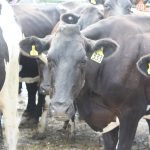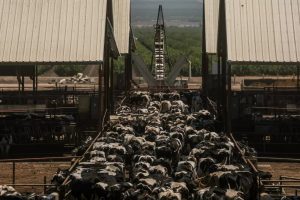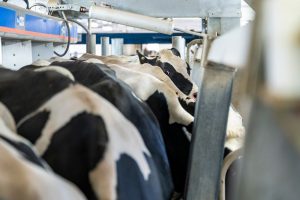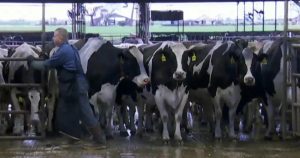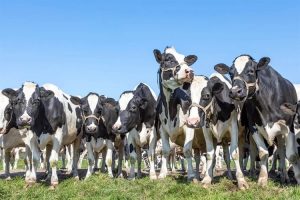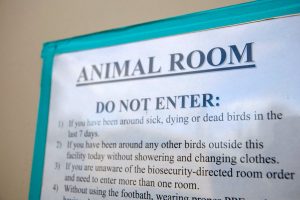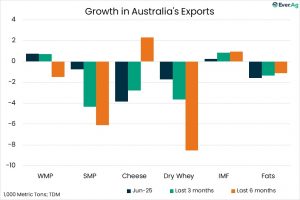
Here’s the latest news about a global outbreak of H5N1 bird flu that started in 2020, and recently spread among cattle in U.S. states and marine mammals across the world, which health officials are closely monitoring and experts are concerned the virus could mutate and eventually spread to humans, where it has proven rare but deadly.

Chickens wait in a cage at the Chicken Market due to bird flu infection.
Getty Images
Timeline
August 30. Three dairies in central California detected the bird flu virus among its herds and have been quarantined, according to the California Department of Food and Agriculture, which noted there are no human bird flu cases related to the incident, as well as no threat to the milk and food supply.
August 29. The July bird flu outbreaks in two Colorado poultry facilities were the country’s first known human cluster of cases caused by poultry—infections were just one-off in the past—though there was no reported human-to-human transmission, according to a new report by the Centers for Disease Control and Prevention.
July 25. Three more human infections were confirmed in workers from a second Colorado poultry facility, bringing the country’s total case count to 14 since 2022, according to CDC data.
July 24. A new Nature study found bird flu spread among cows in the U.S., and the animals also spread the virus to cats and raccoons; this is one of the first studies confirming mammal-to-mammal bird flu transmission.
July 19. The CDC confirmed an additional two bird flu cases in poultry farm workers from the same facility in Colorado, bringing the country’s total human case count to 11.
July 15. Officials confirmed a fourth bird flu case in a poultry farm worker on the same Colorado farm from last week, and a fifth suspected case is pending confirmation from the CDC. This brings the national number to nine since the first human cases was detected in the state in 2022, with eight of the cases reported this year.
July 12. Colorado authorities announced three workers in a commercial egg operation have presumptive positive cases of bird flu, bringing the state’s count of known human infections up to as high as five—and the national number to seven—though authorities said none of the workers have been hospitalized, and showed “common respiratory infection symptoms” and pink eye. It’s the first time multiple cases have been recorded at the same location.
July 3. Colorado health officials confirmed the state’s second human case of bird flu in a dairy farm worker who has since recovered and only had mild symptoms, reporting pink eye.
June 25. Finland said it plans to begin vaccinating vulnerable populations like farm workers against bird flu as early as next week using 10,000 vaccine series—each with two doses—acquired as part of a European Union deal with vaccine maker CSL Seqirus to provide up to 40 million vaccines to 15 countries.
June 11. The World Health Organization announced a four-year-old child in India was infected with H9N2 bird flu—a different flu strain from H5N1—but recovered after suffering from seizures, respiratory distress, fever and abdominal cramps; H9N2 has infected around 100 people globally since 1998, and this is the second human case in India.
June 6. Dozens of cows infected with bird flu have either died or been slaughtered in Colorado, Ohio, Michigan, South Carolina and Texas, which is unusual since—unlike poultry—cows cost more to slaughter and around 90% usually make a full recovery, Reuters reported.
June 5. A new study examining the 2023 bird flu outbreak in South America that killed around 17,400 elephant seal pups and 24,000 sea lions found the disease spread between the animals in several countries, the first known case of transnational virus mammal-to-mammal bird flu transmission.
May 30. Another human case of bird flu has been detected in a dairy farm worker in Michigan—though the cases aren’t connected—and this is the first person in the U.S. to report respiratory symptoms connected to bird flu, though their symptoms are “resolving,” according to the CDC.
May 23. A new study with mice suggests that drinking infected milk can spread the disease—and that a certain type of pasteurization may not always be effective in killing the virus.
May 22. Michigan reported bird flu in a farmworker—the second U.S. human case tied to transmission from dairy cows—though the worker had a mild infection and has since recovered.
May 21. Australia reported its first human case of bird flu after a child became infected in March after traveling to India, though the child has since recovered after suffering from a “severe infection,” according to the Victorian Department of Health.
May 16. The USDA conducted a study, and discovered that after high levels of the virus was injected into beef, no trace was left after the meat was cooked medium to well done, though the virus was found in meat cooked to lower temperatures.
May 14. The CDC released influenza A waste water data for the weeks ending in April 27 and May 4, and found several states like Alaska, California, Florida, Illinois and Kansas had unusually high levels, though the agency isn’t sure if the virus came from humans or animals, and isn’t able to differentiate between influenza A subtypes, meaning the H5N1 virus or other subtypes may have been detected.
May 10. The Food and Drug Administration announced it will commit an additional $8 million to ensure the commercial milk supply is safe, while the Department of Agriculture said it will pay up to $28,000 per farm to help mitigate the spread of the disease, totaling around $98 million in funds.
May 9. Some 70 people in Colorado are being monitored for bird flu due to potential exposure, and will be tested for the virus if they show any symptoms, the Colorado Department of Public Health told Forbes—it was not immediately clear how or when the people were potentially exposed.
May 1. The Department of Agriculture said it tested 30 grocery store ground beef products for bird flu and they all came back negative, reaffirming the meat supply is safe.
May 1. The Food and Drug Administration confirmed dairy products are still safe to consume, announcing it tested grocery store samples of products like infant formula, toddler milk, sour cream and cottage cheese, and no live traces of the bird flu virus were found, although some dead remnants were found in some of the food—though none in the baby products.
April 30. Wenqing Zhang, head of WHO’s Global Influenza Programme, said during a news briefing “there is a risk for cows in other countries to be getting infected,” with the bird flu virus, since it’s commonly spread through the movement of migratory birds.
April 29. The Department of Agriculture told Forbes it will begin testing ground beef samples from grocery stores in states with cow outbreaks, and test ground beef cooked at different temperatures and infected with the virus to determine if it’s safe to eat.
April 24. The USDA said cow-to-cow transmission may be occurring due to the cows coming into contact with raw milk—and warned against humans and other animals, including pets, consuming unpasteurized milk to prevent potential infection.
April 18. Jeremy Farrar, chief scientist for the World Health Organization, said during a press conference the threat of bird flu spreading between humans was a “great concern,” since it’s evolved and has increasingly been infecting mammals (on land and sea), which means it could possibly spread to humans.
April 1. The CDC reported the second U.S. human case of bird flu in a Texas dairy farmer who became infected after contracting the virus from infected dairy cows, but said the person was already recovering.
You can now read the most important #news on #eDairyNews #Whatsapp channels!!!
🇺🇸 eDairy News INGLÊS: https://whatsapp.com/channel/0029VaKsjzGDTkJyIN6hcP1K


